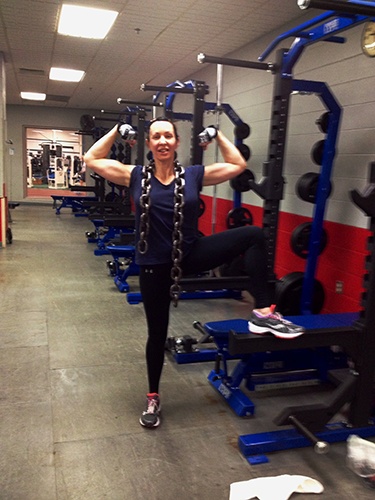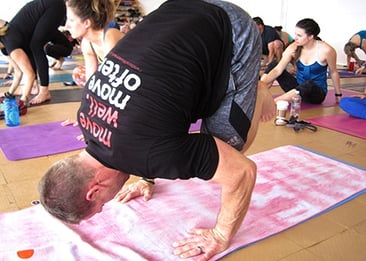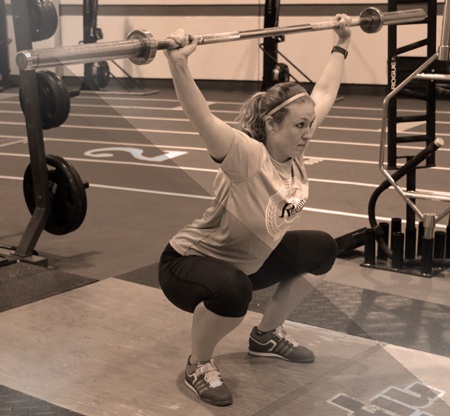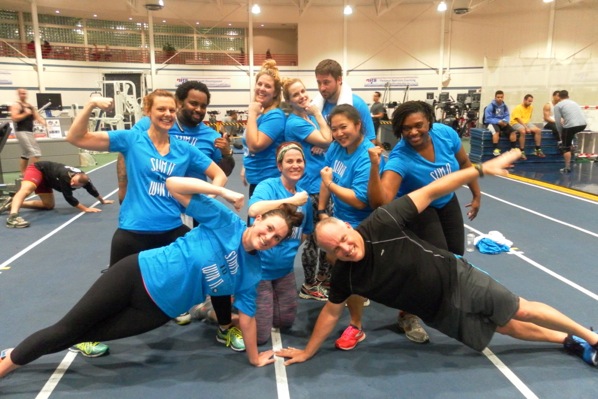 Working with phenomenal people is one of my favorite perks as a fitness professional. I often share that I have the best job on the planet because I get to spend time with just fantastic people. Witnessing the successes, the defeats, the comebacks, and the emotional victories is why I do what I do.
Working with phenomenal people is one of my favorite perks as a fitness professional. I often share that I have the best job on the planet because I get to spend time with just fantastic people. Witnessing the successes, the defeats, the comebacks, and the emotional victories is why I do what I do.
I began working with one of these remarkable individuals about six years ago, and knew right away that she was going to accomplish great things, and make me a better person along the way. Stephanie Whittaker, among so many other warrior-like attributes, has slain the big C, packed on a bunch of muscle, and been a leader in so many programs at NIFS. I had the honor to sit down with this amazing lady and ask her how she has come so far, what are some of her accomplishments, and what is the mindset needed to do it all.
Tony: What, if anything, motivated you toward fitness and wellness?
Stephanie: Seven years ago, NIFS was the starting point for regaining my health. I had recovered from surgical procedures and finished treatments for thyroid cancer and melanoma. Grateful for all that modern medicine had accomplished, it was now my turn to do whatever I could to restore my health and well-being.
Tony: Tell me about some of the struggles you faced at the beginning and throughout your journey, and what helped you overcome them.
Stephanie: One of the biggest struggles was accepting how deconditioned I was (overweight with zero stamina) and not getting overwhelmed by my goal of returning to my former state of health and activity. I remember my first spin class so vividly. I couldn’t keep up with the workout; my only goal was to stay on the bike that day. I was gasping for air and seeing stars, but I stayed on the bike! One of the reasons I could stay on the bike was the welcoming encouragement and energetic support of the instructor (Steven Kass).
Tony: What do you think has had the biggest impact on your transformation?
Stephanie: My ladder of progress over the next year included regular spin classes, participation in Slim It to Win It, and the Mini-Marathon Training Program. I then mustered the courage to challenge myself and try a series of Small Group Training (SGT) classes with Tony. This was my “game changer.” Prior to starting SGT, I went through a battery of physical testing, mobility assessment, and the BOD POD® calculation of my lean-to-fat ratio (oh, great!). The results were sobering; although I was not pleased with my starting metrics, Tony put that information into perspective and provided guidance to help me set achievable goals. If you don’t know the starting point, how can you measure success?
“The group training environment is one of support, encouragement, and celebrating the fun of completing a 60-minute workout that you never would have done left to your own devices.”
Now to the fun part: Group Training has been part of my life for six years. Twice a week I am one of Tony’s “Warriors,” and every Saturday I am one of Mike Bloom’s “Crew.” This is my fitness family. The group training environment is one of support, encouragement, and celebrating the fun of completing a 60-minute workout that you never would have done left to your own devices.
Over the past year I have incorporated personal training sessions focusing on Olympic lifting techniques with Aaron Combs and am making good progress. These skills translate to my group training workouts and overall improved fitness. I also continue with spin class twice a week.
“I have become comfortable with being uncomfortable.”
Tony: Brag time! Tell me about some of your achievements during this time.
Stephanie: First of all, a regularly scheduled fitness evaluation (yes, more BOD POD®) and continued goal setting keeps me on track and moving in the right direction. The numbers don’t lie.
*Starting metrics: 32.8% body fat; Functional Mobility Screening results = 9. I could not do a pull-up; my flexed-arm hang with chin above the bar was 10 seconds.
*Metrics as of December 2015: 20.7% body fat; Functional Mobility Screening results = 19. Pull-ups = 6 consecutive.
*Weight loss claims and/or individual results vary and are not guaranteed.
Tony: What message would you like to pass along to all those out there working to be the best version of themselves?
Stephanie: I am personally accountable for how I live, choices I make, and how hard I work to fulfill my goals and expectations. I approach each of my workouts with a mindset of getting to my “edge” and working that edge. Over time that edge advances. I have become comfortable with being uncomfortable—not injured, but going beyond my comfort level to push my mental and physical boundaries. This is how I have transformed into a more confident, vibrant individual who celebrates life each day.
***
The proof is in the pudding. It takes hard work to accomplish the things you hope to achieve, not just in fitness, but in anything in life. I would never sugar-coat that to anyone; it does take work to do things the right way, and there is no magic pill. Stephanie is a reminder of what hard work looks like, and is an inspiration to those who have or are battling cancer and other powerful diseases. Never give up, never give in, and never take a day for granted are just a few mantras Stephanie lives by. I am honored to have had the opportunity to spend time with her all these years and look forward to witnessing not only her physical accomplishments but her leadership success as well!
Want to get started on your own path to success? Try a small group training class on us

This blog was written by Tony Maloney, ACSM Certified Exercise Physiologist and Fitness Center Manager. To find out more about the NIFS bloggers, click here.
 In my eight years at NIFS, one major thing I am so lucky to have is a world-class fitness facility right outside my office door. Some of the greatest fitness equipment surrounded by some of the greatest fitness minds are at my fingertips every day. I love to move, and I love to move here, but many times I need to move outside of these walls, and of course I will have to leave the awesome gear where it lies.
In my eight years at NIFS, one major thing I am so lucky to have is a world-class fitness facility right outside my office door. Some of the greatest fitness equipment surrounded by some of the greatest fitness minds are at my fingertips every day. I love to move, and I love to move here, but many times I need to move outside of these walls, and of course I will have to leave the awesome gear where it lies. 


 For just shy of a year now, NIFS has had the honor and privilege of assisting in the training of the
For just shy of a year now, NIFS has had the honor and privilege of assisting in the training of the 
 I recently attended an event that was pretty far outside my usual activity base. I consider myself a lifetime mover and a lifetime learner, but I have to admit this event had me a bit concerned about my success rate, comfort level, and quite honestly my enjoyment. After all, I was supposed to be on vacation. The event I am referring to is a rather large one called
I recently attended an event that was pretty far outside my usual activity base. I consider myself a lifetime mover and a lifetime learner, but I have to admit this event had me a bit concerned about my success rate, comfort level, and quite honestly my enjoyment. After all, I was supposed to be on vacation. The event I am referring to is a rather large one called  Prior to this trip to
Prior to this trip to  I am a huge believer that if there is a will, there is a way, and to always find ways to get things done. Just like the tree in the picture growing on top of a rock, it found a way to get tall and strong even though it is out of its usual environment of growing from the ground. IT FOUND A WAY. You can always find a way to eat right, exercise, get enough sleep, decrease stress; you just have to reach and work for it. There is a way; find it. This tree did, and so can you.
I am a huge believer that if there is a will, there is a way, and to always find ways to get things done. Just like the tree in the picture growing on top of a rock, it found a way to get tall and strong even though it is out of its usual environment of growing from the ground. IT FOUND A WAY. You can always find a way to eat right, exercise, get enough sleep, decrease stress; you just have to reach and work for it. There is a way; find it. This tree did, and so can you. So many people have been expectantly waiting for this hot summer weather to be able to get outside for their workouts. And I can tell you that I am also one of those people; but there are some dangers behind the dog days of summer that we all need to be aware of.
So many people have been expectantly waiting for this hot summer weather to be able to get outside for their workouts. And I can tell you that I am also one of those people; but there are some dangers behind the dog days of summer that we all need to be aware of. The deadlift is a creature all its own. There is no other exercise like it, and there are so many reasons behind that. It can be one of the most beneficial total-body exercises, yet at the same time, one of the most detrimental if performed incorrectly. Numerous factors go into this very important lift, but there are a few tricks to keep in mind to help you set up and perform well consistently while avoiding injury.
The deadlift is a creature all its own. There is no other exercise like it, and there are so many reasons behind that. It can be one of the most beneficial total-body exercises, yet at the same time, one of the most detrimental if performed incorrectly. Numerous factors go into this very important lift, but there are a few tricks to keep in mind to help you set up and perform well consistently while avoiding injury. Working with phenomenal people is one of my favorite perks as a fitness professional. I often share that I have the best job on the planet because I get to spend time with just fantastic people. Witnessing the successes, the defeats, the comebacks, and the emotional victories is why I do what I do.
Working with phenomenal people is one of my favorite perks as a fitness professional. I often share that I have the best job on the planet because I get to spend time with just fantastic people. Witnessing the successes, the defeats, the comebacks, and the emotional victories is why I do what I do. 
 Squats, really any variation, are easily one of the most popular exercises out there today. The squat pattern is a fundamental and big-bang movement when done correctly. But before you throw a bunch of weight on a bar and step underneath it, it’s important to focus on some details to help minimize some minimums that will ultimately lead to a cleaner and safer squat.
Squats, really any variation, are easily one of the most popular exercises out there today. The squat pattern is a fundamental and big-bang movement when done correctly. But before you throw a bunch of weight on a bar and step underneath it, it’s important to focus on some details to help minimize some minimums that will ultimately lead to a cleaner and safer squat. With the rapid development of technology, apps for our smartphones are grabbing our attention. In the growing world of hands and eyes being permanently glued to the cell phone, I have to admit that it’s not all bad! Some of our staff here at NIFS would add to the list of helpful apps one that could be a potential lifesaver—it’s called ICE.
With the rapid development of technology, apps for our smartphones are grabbing our attention. In the growing world of hands and eyes being permanently glued to the cell phone, I have to admit that it’s not all bad! Some of our staff here at NIFS would add to the list of helpful apps one that could be a potential lifesaver—it’s called ICE. My first thought after discovering what this was all about was, “Okay, that sounds kind of cool, but that’s a lot of personal information potentially being displayed for all to see if they got ahold of my phone.” But in early February, an emergency event occurred in the
My first thought after discovering what this was all about was, “Okay, that sounds kind of cool, but that’s a lot of personal information potentially being displayed for all to see if they got ahold of my phone.” But in early February, an emergency event occurred in the  The
The  Or Haley Pratt:
Or Haley Pratt: There are so many things in life that can affect different aspects of the human body, and stress is one of the biggest! During a stressful time in life, the body can undergo several physiological changes that can be detrimental to your overall health. Though sometimes we cannot avoid certain stressors that fall into our path of life, there are some things that can be done to help you cope during those times.
There are so many things in life that can affect different aspects of the human body, and stress is one of the biggest! During a stressful time in life, the body can undergo several physiological changes that can be detrimental to your overall health. Though sometimes we cannot avoid certain stressors that fall into our path of life, there are some things that can be done to help you cope during those times.